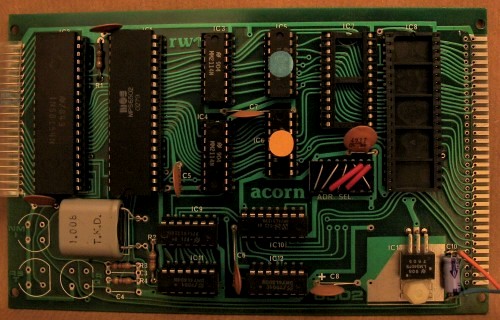More pictures
Timeline & people
Documentation
Firmware
Schematics
Specifications
Emulator Overview
Using the Monitor
Emulator Menus
Mini-Debugger
In addition to describing the computer, I have written an Emulator for it – so you can try it for yourself even if you don't have the original hardware. You might find the emulator useful as an educational resource, too, as it really shows how to program a computer at the hardware level (and with the mini-debugger you can watch the registers and other internal state changing as instructions are executed).
The Acorn Keyboard
The computer was primarily sold as a kit; two Eurocard boards (160mm x 100mm) had first to be populated and wired together. These form a self-contained and unusually compact computer, needing only a 9-volt power supply. The visible (top) board is the Acorn Keyboard:
In addition to the white keyboard, this board also holds a
9-digit calculator-style 7-segment LED display (of which only
8 digits can be used) and, on the left, circuitry for the
cassette recorder interface (and a scan decoder).
![]() Here's a simulated recording of the first 128 bytes of the
Acorn Monitor program, as would be recorded on a cassette tape
(your browser may need a plug-in to play this MIDI file).
Here's a simulated recording of the first 128 bytes of the
Acorn Monitor program, as would be recorded on a cassette tape
(your browser may need a plug-in to play this MIDI file).
In this picture the display is showing the contents of the memory location at address (A.) FE00, namely A0. This is the first byte of the firmware monitor program.
On the keyboard, the sixteen keys on the left provide for hexadecimal input values. The eight keys to their right initiate the following command functions:
| m | (modify) Memory display and modification | l | (load) Reads a block of bytes from tape |
| g | (go) Run program starting at an address | r | (return) Resume after a breakpoint |
| p | (point) Inserts or removes breakpoint | ^ | (up) Increment displayed address |
| s | (store) Writes a block of bytes to tape | v | (down) Decrement displayed address |
The rst key resets the microprocessor, which starts the monitor program (which in turn initially displays eight dots, then waits for a command key to be pressed).
The Acorn Microcomputer
The lower board is the Acorn Microcomputer proper:
It holds (from left to right, top row):
- National Semiconductor INS8154N RAM/IO chip (128 bytes RAM plus receivers and drivers for display and keyboard)
- MOS Technologies MPS6502 Microprocessor [0279]
- Two 2114 static RAM chips (each 1024x4-bit, 1KiloByte total)
- Two 74S571 PROM chips (each 512x4-bit, 512 Bytes total)
- Sockets for additional PROM and RAM/IO chips
- Pads for a EuroConnector.
The board was also marketed as a ‘Single Board Controller’ without the RAM and ROM chips.
 Click for a larger image
Click for a larger image Click for a larger image
Click for a larger image